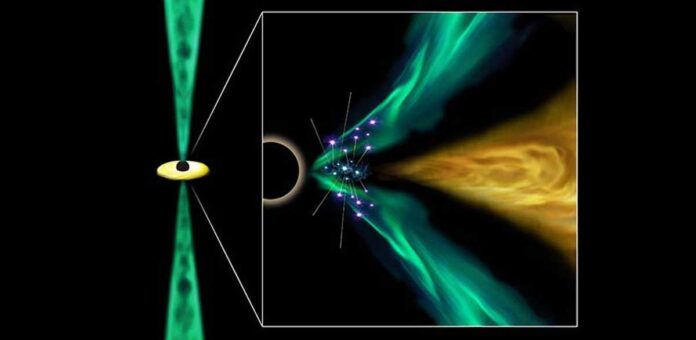Galaxies, including our Milky Way, contain supermassive black holes with masses millions to billions of times greater than the sun. Some supermassive black holes produce radio jets, which are fast-moving plasma outflows that emit strong radio signals.
Radio jets were discovered for the first time in the 1970s. However, much is unknown about how they are created, particularly their energy source and plasma loading mechanism.
The Event Horizon Telescope Collaboration recently discovered radio images of a nearby black hole at the heart of the massive elliptical galaxy M87. The discovery supported the theory that the black hole’s spin powers radio jets but did little to explain the plasma loading mechanism.
Now, a research team led by astrophysicists from Tohoku University has proposed a promising scenario that clarifies the plasma loading mechanism into radio jets.
According to recent research, black holes are highly magnetised because magnetised plasma within galaxies carries magnetic fields into the black hole. Then, via magnetic reconnection, neighbouring magnetic energy transiently releases its energy, energising the plasma surrounding the black hole. This magnetic reconnection is the source of energy for solar flares.
Plasmas in solar flares emit ultraviolet and X-rays, whereas magnetic reconnection around a black hole can emit gamma-rays because the energy released per plasma particle is much higher than in a solar flare.
According to the current scenario, the emitted gamma rays interact with each other and generate a large number of electron-positron pairs, which are then loaded into the radio jets.
This explains why there is so much plasma in radio jets, which is consistent with the M87 observations. Furthermore, the scenario mentions that radio signal strengths differ from black hole to black hole. Radio jets, for example, are too faint and undetectable by current radio facilities around Sgr A*, our Milky Way’s supermassive black hole.
In addition, when plasma is loaded into radio jets, the scenario predicts short-term X-ray emission. Current X-ray detectors miss these X-ray signals, but planned X-ray detectors can see them.
“Under this scenario, future X-ray astronomy will be able to unravel the plasma loading mechanism into radio jets, which has long been a mystery of black holes,” says Shigeo Kimura, the study’s lead author. Kimura and his colleagues’ findings were published in The Astrophysical Journal Letters on September 29, 2022.

